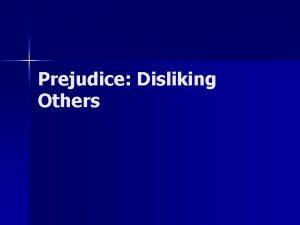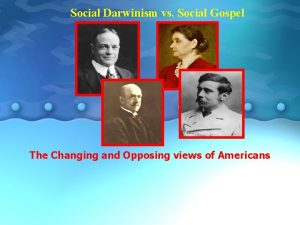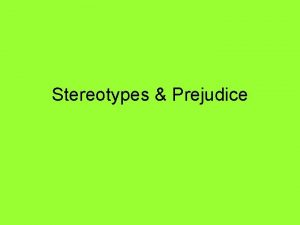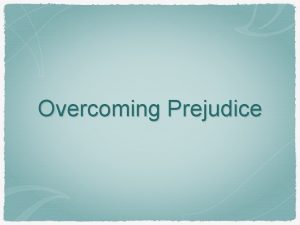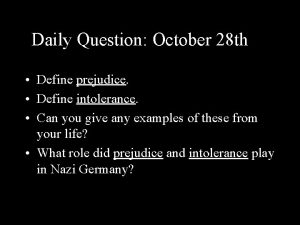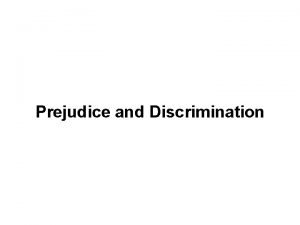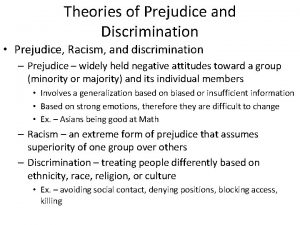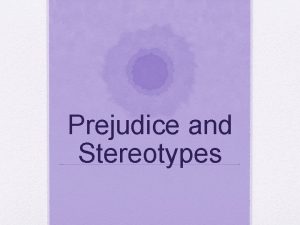77 1 Define prejudice and identify its social












- Slides: 12


77. 1 – Define prejudice, and identify its social and emotional roots. Prejudice and Stereotypes • Prejudice, a positive or negative belief about a category of people, refers to prejudging a person because he or she belongs to a specific group. The components of prejudice include beliefs (stereotypes), emotions (hostility, envy, fear), and predisposition to act (to discriminate). Stereotyping refers to the generalization of a particular group of people based on a preexisting concept or image; stereotyping involves generalizing an attitude toward a larger segment of the population. Discrimination is differing treatment toward a category of people. Discrimination may involve preferential treatment of some good or service to a group of people, typically people of a different ethnicity, religion, or gender. It is important to note that both stereotyping and discrimination can occur in either a positive or negative manner. The psychology behind prejudice, discrimination, and stereotyping is based on three main factors: motivational, cognitive, and behavioral.

77. 1 – Define prejudice, and identify its social and emotional roots. • Prejudice • An unjustifiable and negative attitude toward a group; based on stereotypes • Generally involves beliefs, emotions & behavioral dispositions • Explicit Prejudice v. Implicit Prejudice • Discrimination • Unjustifiable & negative behavior toward the members of a group • Do prejudice and discrimination always go hand-in-hand?

77. 1 – Define prejudice, and identify its social and emotional roots. • Prejudice Examples • In one study, most white participants perceived a white man shoving a black man as “horsing around; ” however, when they saw a black man shoving a white man, they interpreted it as “violence” • A black New Jersey dentist who drove a gold BMW was stopped more than 75 times within a year • People tend to perceive fathers as being more intelligent than mothers • Female circumcision in some African countries

77. 1 – Define prejudice, and identify its social and emotional roots. • Prejudice Examples • In Los Angeles, 1115 landlords received identically worded emails from a would-be tenant (actually a researcher) expressing interest in vacant apartments advertised online • Encouraging replies came back to: • 56% of emails signed “Tyrell Jackson” • 66% signed “Said Al-Rahman” • 89% of those signed “Patrick Mc. Dougall”

77. 1 – Define prejudice, and identify its social and emotional roots. Prejudice and Stereotypes 1) Motivational • Definition: the belief that prejudice, stereotyping, and discrimination are the result of an underlying reason, such as self-preservation, self-identity, or in-group bias. • Example – Jackie and her friends ridicule a fellow classmate in order to increase their own self-esteem and sense of self-importance. 2) Cognitive • Definition: the use of mental shortcuts (heuristics) to form an impression about a group of people. • Example – Hank’s brother wears glasses and reads; therefore, Hank believes that all people who wear glasses like to read. 3) Behavioral • Definition: A person models the behaviors he sees and hears at home, on television, or from his peers. • Example – Max’s parents often talk negatively about people who are of a different race. One day at school Max began calling all such students names.

77. 1 – Define prejudice, and identify its social and emotional roots. Subtle Prejudice • despite decreases in overt prejudices, subtle prejudice still lingers. • for example, many people verbally support interracial marriage, but admit that in socially intimate settings they would feel uncomfortable with someone of another race.

77. 1 – Define prejudice, and identify its social and emotional roots. Subtle Prejudice • Gender • more women still live in poverty than men. • about 100, 000 women are missing in the world. • there is a preference for male children in China and India, even with sex-selected abortion outlawed. • although prejudice prevails against women, more people fell positively toward women than men.

77. 1 – Define prejudice, and identify its social and emotional roots. Subtle Prejudice • The Just-World Phenomenon • the tendency of people to believe the world is just, and people get what they deserve and deserve what they get. • from here it is a short leap to assume that those who suffer must be bad.

77. 1 – Define prejudice, and identify its social and emotional roots. Subtle Prejudice • Us and Them • In-Group – people with whom one shares a common identity. • Out-Group – those perceived as different from one’s in-group. • In-Group Bias – the tendency to favor one’s own group.

77. 1 – Define prejudice, and identify its social and emotional roots. Subtle Prejudice • Scapegoat Theory • prejudice provides an emotional outlet for anger by providing someone to blame. • after 9/11 many people lashed out against innocent Arab. Americans.

77. 2 – Identify the cognitive roots of prejudice. Forming Categories • one way we simplify our world is to categorize. • in categorizing people into groups, however, we often stereotype them and overestimate their homogeneity.
 Nature and power of prejudice
Nature and power of prejudice Social gospel vs social darwinism
Social gospel vs social darwinism Thrombolytic prefix and suffix
Thrombolytic prefix and suffix Identify and define the root in the word automobile
Identify and define the root in the word automobile They accuse me of being dark in their free city
They accuse me of being dark in their free city Its halloween its halloween the moon is full and bright
Its halloween its halloween the moon is full and bright Verbal irony pride and prejudice
Verbal irony pride and prejudice Social thinking social influence social relations
Social thinking social influence social relations Social thinking social influence social relations
Social thinking social influence social relations Plant layout
Plant layout Scope of micro biology
Scope of micro biology Mention any two nature of educational psychology
Mention any two nature of educational psychology Non vertex angles
Non vertex angles
